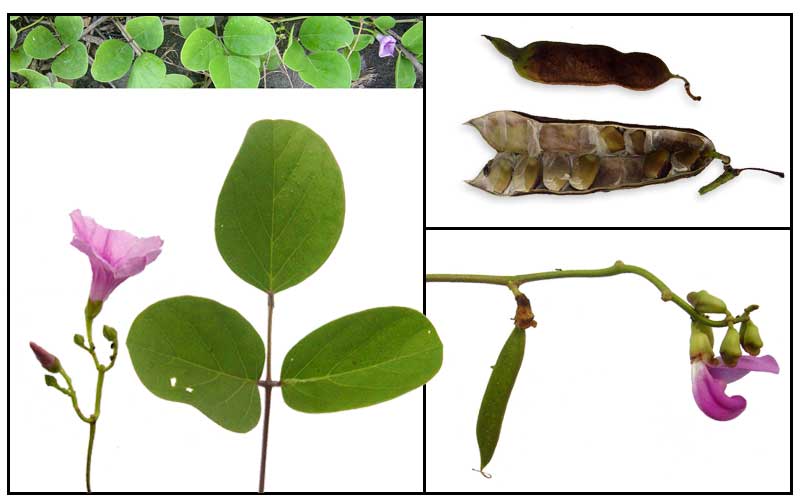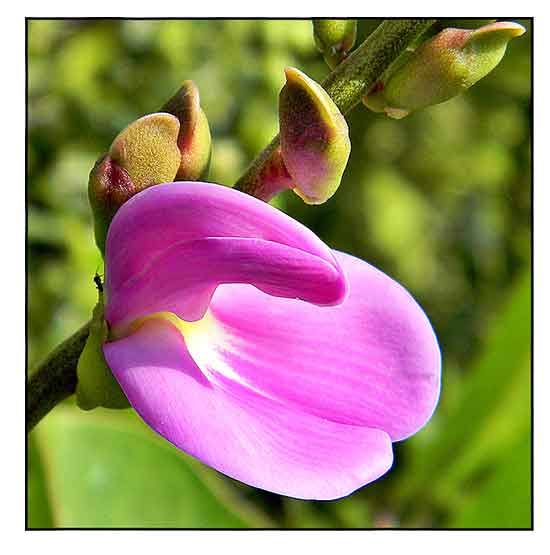|

Gen info
- Canavalia is a genus of plants in the legume family Fabaceae, comprising approximately 62 species of tropical vines. Members of the genus are called jack-beans. Distribution is pantropical. (20)
-
Etymology: The genus name Canavalia derives from the Malabar vernacular name, kanavali, for climbing herbs or sub-shrubs. The specific epithet derives from Latin rosea, meaning "rose-like", referring to the pink flowers. (18)
Botany
Pataning-dagat is a vigorous prostrate twining vine with sparsely puberulent stems. Leaves are
alternate, compounded and long-petioled with 3 broad obovate
leaflets, 2 to 15 centimeters long. The inflorescence is a long peduncled
raceme with a few paired pink-purple pea type flowers about 4
centimeters long. Stamens are ten in number united into a tube covering
the elongated ovary. The pods are rough, turgid, 8 to 12 centimeters
long and 2 to 3 centimeters wide with fairly large seeds. New plants start
vegetatively from runners.
Distribution
- Native to the Philippines.
-
Found along tidal streams, brackish swamps
and muddy banks throughout the Philippines.
- The flowers are wind pollinated.
- Seeds are dispersed from the pods and transported by water to distant
places.
- Found in most coastal tropical beaches, cliffs, and dunes.
 Constituents Constituents
• Plant yields alkaloids, phenols, saponins. Leaves yield cyanogens.
• An active principle,
L-betonicine has been isolated, with no conclusive hallucinogenic evidence.
• Assessment of biochemical and protein quality of thermally treated seeds showed protein and energy values surpassing common pulse crops. Fatty acids and carbohydrates in test seeds were superior to those of soybean; and essential amino acids phenylalanine and lysine of treated seeds were higher than WHO/FAO reference. (6)
• Proximate and mineral composition of seed flours on dry weight basis yielded in gms or mg per 100 gr: moisture 9.3 ± 0.13%, crude protein 34.1 ±0.52 g; crude lipid 1.7 ± 0.1 g; crude fiber 10.2 ± 0.18 g; ash 3.5 ± 0.18 g; crude carbohydrate 50.5 ±0.53 g; energy value 1586 ± 8 KJ; total protein 29.3 ± 0.6 g; sodium 47.96 ±0.73 mg; potassium 974.32 ± 5.99 mg; calcium 86.16 ± 4.27 mg; phosphorus 158 ± 2.28 mg; magnesium 23.13 ± 0.o2; zinc 13.08 ±1.2 mg; manganese 2.01 ± 0.21 mg. (6)
 • Ethanol extract of grounded and air-dried leaves and stems yielded pterocarpin and isoflavan derivatives elucidated as 2- hydroxy-3, 9-dimethoxypterocarpin (1), 4-hydroxy-3-methoxy-8,9-methylenedioxypterocarpan (2), medicarpin (3), 7-hydroxy-2',4'-dimethoxy isoflavan (4), 7-hydroxy-4'-methoxyisofalvone (5) 5,7,4'-trihydroxyisoflavone (6), 3,7-dihydroxy-6-methoxylflavone (7), and quercetin (8). (7) • Ethanol extract of grounded and air-dried leaves and stems yielded pterocarpin and isoflavan derivatives elucidated as 2- hydroxy-3, 9-dimethoxypterocarpin (1), 4-hydroxy-3-methoxy-8,9-methylenedioxypterocarpan (2), medicarpin (3), 7-hydroxy-2',4'-dimethoxy isoflavan (4), 7-hydroxy-4'-methoxyisofalvone (5) 5,7,4'-trihydroxyisoflavone (6), 3,7-dihydroxy-6-methoxylflavone (7), and quercetin (8). (7)
• Screening of crude leaf extracts yielded tannins, phlobatannins, saponins, flavonoids, alkaloids, cardiac glycosides, and phenolics. (see study below) (11)
• Study
of aerial parts yielded a new acyclic guanidine alkaloid, canarosine, together with five known compounds: ß-sitosterol (1), stigmasterol (2), daucosterol (3), epi-inositol 6-O-methyl ether (4), and rutin (5). (see study below) (3)
• Study of fatty acid composition of seed flour (g/100g lipid) yielded: (Saturated fatty acids) palmitic acid 2.18. stearic acid 20.9; (Polyunsaturated fatty acids) palmitoleic acid ND, oleic acid 63, linoleic acid 11.5, linolenic acid ND; and P/S (polyunsaturated/saturated fatty acid) ratio of 3.22. (13)
• Study of Canavalia maritima seed flour for antinutritional components (mg/100 g dw basis) yielded total
phenolics 1370±0.04, with +++ phytohemagglutinin activity, and absence of tannins and trypsin inhibitory activity. (13)
• Phytochemical screening of extract of powdered leaves yielded carbohydrates, alkaloids, sterols, flavonoids, saponins, tannins, and phenolic compounds.
(see study below) (16)
• Proximate composition of beach bean seed and leaf yielded: % moisture
12.24 and 11.06; % ash content 2.53 and 8.45;% crude fiber 3.84 and 3.99; % fat content 3.57 and 5.31; % crude protein 50.84 and 30.59; % carbohydrate 26.98 and 40.60. (19)
• Phytochemical screening of leaf and seed extracts yielded alkaloids, carbohydrates, cardiac glycosides, fats and oils, flavonoid, saponin, steroids, terpenoids, tannins (only in leaves) and absence of anthraquinone in both.
(19)
• Vitamin content in seeds and leaves
(mg/100mL) yielded: A 130 and 141; B 252 and 243, C 5 and 7, E 6 and 8. Mineral composition of seeds and leaves (mg/100 g dry matter) yielded: Na 49 and 38, K 981 and 789, Ca 301 and 468, Mg 123 and 98, Fe 58 and 43, Zn 15 and 13, P) 620 and 590. (19)
Properties
•
Considered aphrodisiac.
• Studies suggest antibacterial, dopamine receptor inhibitory, cytotoxic, anti-biofilm, antiplasmodial, antiviral, smooth muscle relaxant, CNS depressant properties.
Parts
used
Leaves, shoots, seeds, roots.
Uses
Edibility
- Seeds are edible and serve
as an important source of dietary protein in West Africa and Nigeria.
- Tender pods and seeds may be boiled or roasted.
- When mature, pods and seeds are soaked before being eaten to remove toxins.
- Roasted beans added to coffee.
- Flowers used for making spice.
Folkloric
- Juice from the petioles applied
to puncture wounds by thorns or other sharp objects.
- Decoction of leaves used for rheumatism.
- Paste of leaves used for boils and sores.
- In Samoa, plant potion used during
labor.
- Shoot decoction used to treat tuberculosis. Roots used for treatment of ciguatera fish poisoning, aches, pains, rheumatism, and leprosy. Leaf extracts used for burns, and as styptic. (6)
- In Tonga, hot water infusion of leaves with other plants used to treat secondary amenorrhea and postpartum hemorrhage. (7)
- Used as aboriginal bush medicine in Australia: root extract rubbed on skin to relieve various aches and pains. (14)
- In Australia, the beans soaked in water and pounded into cakes, used for baldness (Petrie 1904). In Broome, Western Australia, root infusion applied locally for aches and pains, rheumatism, leprosy, and for treating colds. (15)
Others
• Fodder: In Africa and Southeast Asia, used as fodder because of high protein content of leaves, flowers, fruits, and seeds. (6)
• Entheogen: Dried leaves have
been used as entheogen, a component to some ancient rituals. In ancient Peru, the fruit had ritual and magical significance.
• Marijuana substitute: In South America, Africa and
Gulf Coast of Mexico, beans of C. maritima are ingested or smoked
with the dried leaves for marijuana-like effects. Has an increasing following for its use as a marijuana substitute.
• Tobacco substitute: Used by herbalists as a natural tobacco alternative.
Studies
• Phytochemicals: Albumins and globulins are the major storage proteins, constituting 90% of the total proteins in Canavalia seeds. Total phenolics were low, while tannins and trypsin inhibition were absent. As with other legumes, Canavalia seeds possess antinutritional factors such as phenolics and phytohemagglutinins. (2)
• Canarosine / Dopamine D1 Receptor Inhibition: Study yielded a new acyclic alkaloid, canarosine, together with five known compounds. Canarosine, at concentration of 100 µg/ml, showed 91% inhibition of the dopamine D1 receptor binding with IC50 of 39.4±5.8 µM. (see constituents above) (3)
• Lectin / Vascular Smooth Muscle Relaxation / Seeds: Study of a lectin from Cm seeds and its relaxant activity on vascular smooth muscle showed that CM exerts a concentration-dependent relaxant action on isolated aortic rings probably via an interaction with a specific lectin-binding site on the endothelium, resulting in a release of nitric oxide. (4)
• ConM Lectin / Alteration of Biofilm Formation in Strep mutans: Study evaluated the effects of ConM and concanavalin A (ConA) on the expression of genes related to virulence and biofilm formation in Streptococcus mutans. S. mutans is the biofilm-forming bacterium primarily associated with dental caries. Results showed ConM significantly reduced the expression of genes encoding enzymes related to adhesion, formation and regulation of biofilms. ConA did not alter the expression of genes studied. (8)
• Nutritional Evaluation of Tender Pods: Study evaluated the nutritional, antinutritional and protein qualities of tender pods of C. maritima. Crude protein was comparable to many edible legumes. Cooking significantly elevated carbohydrates and calorific value of tender pod, while crude fiber was significantly decreased. Minerals did not drain too much on cooking; K, Mg, Zn and Mn in fresh or cooked pods were comparable or higher than the NRC-NAS recommended pattern. While cooking decreased the essential amino acids, threonine, valine, isoleucine, phenylalanine and lysine in cooked pods. levels were equivalent or higher than the FAO-WHO-UNU recommended pattern. Also, pressure cooking improved nutritional qualities by lowering the hemagglutinin activity. (9)
• Anticancer / Cytotoxic on Cancer Cell Lines MCF-7 and HT-29: Methanol extract of cooked (C. maritima) and fermented (C. cathartica) split beans showed better in vitro anticancer activities compared to the raw beans. Results suggest a potential for the extracts of cooked/fermented beans to control colon cancer by diet management. (10)
• Antibacterial / Leaves: Evaluation of various leaf extracts of Canavalia rosea showed high activity against microganisms B. cereus, B. megaterium, B. stearothemophilus, B. subtilis, Staphylococcus aureus, and Streptococcus faecalis. Gram negative bacteria were not as susceptible. (see constituents above) (11)
• Canarosine / Antiplasmodial / Anti-Herpes Type 1 / Leaves: Study of aerial parts isolated six compounds including a new guanidine alkaloids, canarosine, a flavonoid glycoside, rutin, epi-inositol 6-O-methyl ether, β-sitosterol glucoside, and a 2:1 mixture of β-sitosterol and stigmasterol. Canarosine caused 95% inhibition of dopamine-1 receptor binding. The alkaloids was also active against P. falcifarum K1 strain, with moderate activity against Herpes simplex virus type 1. (12)
• Central Nervous System Depressant Effects / Toxicity Study / Leaves: Study evaluated the CNS activity of an ethanolic extract of C. maritima using behavioral studies such as potentiation of phenobarbitone sleeping time, actophotometer activity test, rotarod test, forced swim test, haloperidol induced catalepsy test in mice and rats. Acute oral toxicity study of ethanolic extract of leaves done per OECD 425 guideline showed an LD50 > 2000 mg/kg. Results showed CNS depressant effects as evidenced by reduction in locomotor activity, significant dose dependent myorelaxant activity, dose-dependent sedative and anxiolytic effect. (16)
• Lectins ConA and ConM / Antifungal Effect / Effect in Combination with Fluconazole / Seeds: Lectins participate in the defense against microorganisms and in signaling the damage caused by pathogens to the cell surface and/or intracellularly in plants. Study analyzed the antifungal potential of lectins extracted from Canavalia rosea and C. ensiformis against Candida albicans and C. tropicalis. Results of minimum inhibitory concentration showed no antifungal activity against the tested strains. However, lectins modified the action of fluconazole, reducing the IC50 of the drug against C. albicans. Lectins also modulated the morphological transition of the tested strains. (17)
Availability
- Wildcrafted.
- Extracts and seeds in the cybermarket.
|



